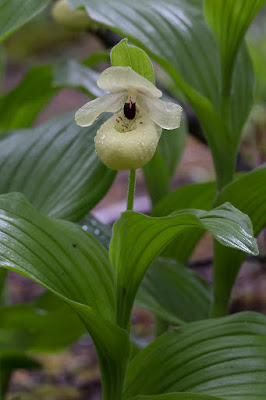Cypripedium flavum is native to China. These orchids are found in south-eastern Xizang (Tibet), the southwestern part of the Yunnan Province, the Sichuan Province, western Hubei and the south of Gansu...
Cypripedium flavum also called as The Yellow Cypripedium, Cypripedium luteum, is a species of the genus Cypripedium. This species was described by Peter Francis Hunt & Victor Samuel Summerhayes in 1996.
IDENTIFY CYPRIPEDIUM FLAVUM
Cypripedium flavum is native to China. These orchids are found in south-eastern Xizang (Tibet), the southwestern part of the Yunnan Province, the Sichuan Province, western Hubei and the south of Gansu. They usually grow in open forest areas and are found both in places covered with grass and on rocks, on the edges of coniferous and mixed forests, and along icy streams, at heights of 1800-3700 m.
It is a medium to large sized, cool to cold growing terrestrial, which reaching a height of 30-50 cm, with 6 to 10, ovate, pubescent, 10-16 cm long and 4-8 cm wide leaves on an erect, brown, pubescent, 30-50 cm tall stem.
The Yellow Cypripedium blooms in the late spring and early summer on a solitary, rarely 2 flowered, slender stalked, 6.25 to 22.5 cm long, terminal inflorescence and carrying color variable flowers. The flowers are 6.25 to 8.75 cm in diameter. They are yellow and usually have auburn spots inside the lip, and may also have scattered auburn-red spots outside the lip entrance. Occasionally, also the dorsolateral and petals of the inner whorl may have a chestnut-red marking.
CYPRIPEDIUM FLAVUM CARE AND CULTURE
Cultural information should only be used as a guide, and should be to be adapted to suit you. Your physical location; where you grow your plants, how much time you have to devote to their care, and many other factors, will need to be taken into account. Only then can you decide on the cultural methods that best suit you and your plants.
Light:
Cypripedium flavum needs a light level of 30000-40000 lux. The light should be slightly filtered or scattered, and the plants can never be exposed to the midday sun. They can be exposed to the sun early in the morning, but for the rest of the day they should be shaded. Strong air movement should be ensured all the time.
Temperature:
The average temperature of the summer day is 21 ° C, the night 12-13 ° C, and the daily amplitude is 8-9 ° C. The average temperature of the winter day is 11-13 ° C, the night from -3 to -1 ° C, and the daily amplitude 12-16 ° C.
Humidity:
In the summer and early autumn, The Yellow Cypripedium needs the average humidity of 75-80%, but in winter and at the beginning of spring it falls to 45-50%.
Substrate, growing media and repotting:
Cypripedium flavum are probably best grown in relatively large containers. The medium recommended consist of 2 parts of clay garden soil, 2 parts of thick leaf moth, 1 part of coarse sand and 1 part of chopped sphagnum. Such a substrate can be used both for growing in pots and for plants growing in an open area of a rock garden.
Watering:
In the summer and early autumn the precipitation is abundant. Their average falls quickly in autumn and there is a dry season, lasting from mid-autumn until the next spring. The cultivated plants should be abundantly watered during the growing season, but excellent drainage must be ensured, and the substrate around the roots can not be soggy. When the growth and blooming end in autumn, the amount of water should be reduced.
Fertilizer:
It is recommended to apply a 1/4-1/2 dose of orchid fertilizer weekly. You can use a balanced fertilizer throughout the year. You can also use high-nitrogen fertilizer from spring to mid-summer, and then high-phosphoric fertilizer until the end of autumn.
Rest period:
If the Cypripedium flavum are planted at the rebate, in autumn they should be protected with a thick layer of dead leaves. When growing in pots, the substrate can never dry up completely. If the plants are grown in a cold greenhouse, it should be kept at 5 ° C or lower in winter, but not fall below 0 ° C. The substrate should be kept slightly moist and ensure good air circulation.















COMMENTS